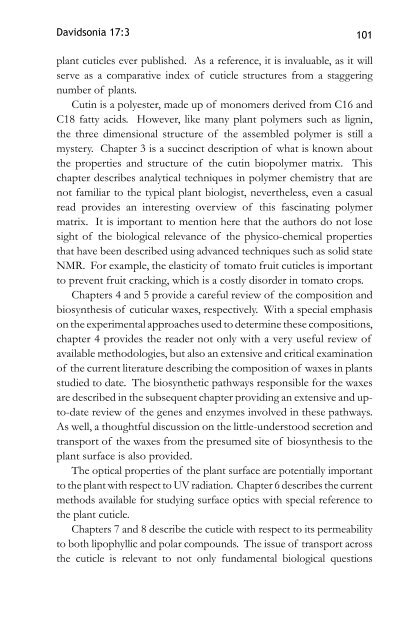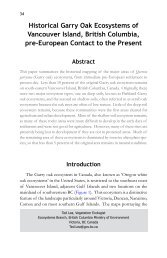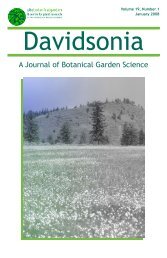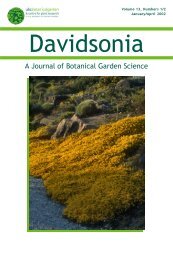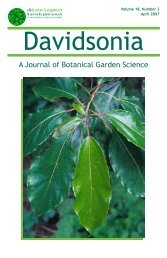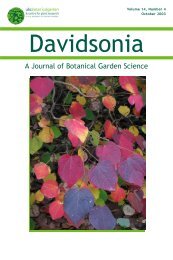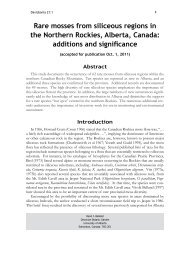Viscin Cells in the Dwarf Mistletoe Arceuthobium ... - Davidsonia
Viscin Cells in the Dwarf Mistletoe Arceuthobium ... - Davidsonia
Viscin Cells in the Dwarf Mistletoe Arceuthobium ... - Davidsonia
- No tags were found...
Create successful ePaper yourself
Turn your PDF publications into a flip-book with our unique Google optimized e-Paper software.
<strong>Davidsonia</strong> 17:3 101<br />
plant cuticles ever published. As a reference, it is <strong>in</strong>valuable, as it will<br />
serve as a comparative <strong>in</strong>dex of cuticle structures from a stagger<strong>in</strong>g<br />
number of plants.<br />
Cut<strong>in</strong> is a polyester, made up of monomers derived from C16 and<br />
C18 fatty acids. However, like many plant polymers such as lign<strong>in</strong>,<br />
<strong>the</strong> three dimensional structure of <strong>the</strong> assembled polymer is still a<br />
mystery. Chapter 3 is a succ<strong>in</strong>ct description of what is known about<br />
<strong>the</strong> properties and structure of <strong>the</strong> cut<strong>in</strong> biopolymer matrix. This<br />
chapter describes analytical techniques <strong>in</strong> polymer chemistry that are<br />
not familiar to <strong>the</strong> typical plant biologist, never<strong>the</strong>less, even a casual<br />
read provides an <strong>in</strong>terest<strong>in</strong>g overview of this fasc<strong>in</strong>at<strong>in</strong>g polymer<br />
matrix. It is important to mention here that <strong>the</strong> authors do not lose<br />
sight of <strong>the</strong> biological relevance of <strong>the</strong> physico-chemical properties<br />
that have been described us<strong>in</strong>g advanced techniques such as solid state<br />
NMR. For example, <strong>the</strong> elasticity of tomato fruit cuticles is important<br />
to prevent fruit crack<strong>in</strong>g, which is a costly disorder <strong>in</strong> tomato crops.<br />
Chapters 4 and 5 provide a careful review of <strong>the</strong> composition and<br />
biosyn<strong>the</strong>sis of cuticular waxes, respectively. With a special emphasis<br />
on <strong>the</strong> experimental approaches used to determ<strong>in</strong>e <strong>the</strong>se compositions,<br />
chapter 4 provides <strong>the</strong> reader not only with a very useful review of<br />
available methodologies, but also an extensive and critical exam<strong>in</strong>ation<br />
of <strong>the</strong> current literature describ<strong>in</strong>g <strong>the</strong> composition of waxes <strong>in</strong> plants<br />
studied to date. The biosyn<strong>the</strong>tic pathways responsible for <strong>the</strong> waxes<br />
are described <strong>in</strong> <strong>the</strong> subsequent chapter provid<strong>in</strong>g an extensive and upto-date<br />
review of <strong>the</strong> genes and enzymes <strong>in</strong>volved <strong>in</strong> <strong>the</strong>se pathways.<br />
As well, a thoughtful discussion on <strong>the</strong> little-understood secretion and<br />
transport of <strong>the</strong> waxes from <strong>the</strong> presumed site of biosyn<strong>the</strong>sis to <strong>the</strong><br />
plant surface is also provided.<br />
The optical properties of <strong>the</strong> plant surface are potentially important<br />
to <strong>the</strong> plant with respect to UV radiation. Chapter 6 describes <strong>the</strong> current<br />
methods available for study<strong>in</strong>g surface optics with special reference to<br />
<strong>the</strong> plant cuticle.<br />
Chapters 7 and 8 describe <strong>the</strong> cuticle with respect to its permeability<br />
to both lipophyllic and polar compounds. The issue of transport across<br />
<strong>the</strong> cuticle is relevant to not only fundamental biological questions


